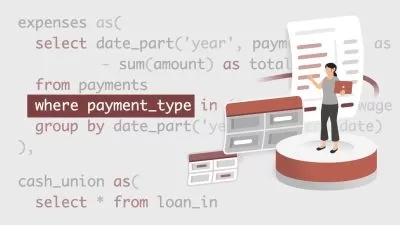00001 What Does the Course Cover.mp4
04:12
00002 Python.mp4
00:32
00003 Why Python.mp4
05:07
00004 Jupyter.mp4
00:31
00005 Setting Up the Environment.mp4
01:24
00006 Programming Explained in 5 Minutes.mp4
05:04
00007 Why Jupyter.mp4
03:29
00008 Installing Anaconda.mp4
04:00
00009 Jupyter s Interface the Dashboard.mp4
03:10
00010 Jupyter s Interface Prerequisites for Coding.mp4
06:09
00011 Jupyter - Using Shortcuts.mp4
03:07
00012 Jupyter - Handling Error Messages.mp4
05:52
00013 Jupyter - Restarting the Kernel.mp4
02:17
00014 Python Variables.mp4
04:52
00015 Understanding Numbers and Boolean Values.mp4
03:05
00016 Strings.mp4
05:40
00017 The Arithmetic Operators of Python.mp4
03:23
00018 What is the Double Equality Sign.mp4
01:33
00019 How to Reassign Values.mp4
01:08
00020 How to Add Comments.mp4
01:34
00021 Understanding Line Continuation.mp4
00:49
00022 How to Index Elements.mp4
01:18
00023 How to Structure Your Code with Indentation.mp4
01:44
00024 Python Comparison Operators.mp4
02:10
00025 Python s Logical and Identity Operators.mp4
05:35
00026 Getting to Know the IF Statement.mp4
03:01
00027 Adding an ELSE statement.mp4
02:45
00028 Else if for Brief ELIF.mp4
05:34
00029 An Additional Explanation of Boolean Values.mp4
02:13
00030 How to Define a Function in Python.mp4
02:02
00031 How to Create a Function with a Parameter.mp4
03:49
00032 Another Way to Define a Function.mp4
02:36
00033 How to Use a Function within a Function.mp4
01:49
00034 Use Conditional Statements and Functions Together.mp4
03:06
00035 How to Create Functions that Contain a Few Arguments.mp4
01:16
00036 Built-In Functions in Python Worth Knowing.mp4
03:56
00037 Introduction to Lists.mp4
04:02
00038 Using Methods in Python.mp4
03:19
00039 What is List Slicing.mp4
04:30
00040 Working with Tuples.mp4
03:11
00041 Python Dictionaries.mp4
04:04
00042 Using For Loops.mp4
02:56
00043 Using While Loops and Incrementing.mp4
02:25
00044 Use the range Function to Create Lists.mp4
03:49
00045 Combine Conditional Statements and Loops.mp4
03:11
00046 All In Conditional Statements Functions and Loops.mp4
02:27
00047 How to Iterate over Dictionaries.mp4
03:07
00048 Object-Oriented Programming.mp4
05:00
00049 Modules Packages and the Python Standard Library.mp4
04:24
00050 Importing Modules.mp4
03:24
00051 What is Software Documentation.mp4
03:57
00052 The Python Documentation.mp4
06:14
00053 Must-Have Packages Fin DSc.mp4
04:53
00054 Arrays.mp4
06:02
00055 Generating Random Numbers.mp4
02:52
00056 Using Financial Data in Python.mp4
02:39
00057 Importing Data Part I.mp4
03:44
00058 Importing Data Part II.mp4
07:01
00059 Importing Data Part III.mp4
04:19
00060 Changing the Index of Your Time-Series Data.mp4
03:17
00061 Restarting the Jupyter Kernel.mp4
02:17
00062 Considering Both Risk and Return.mp4
02:27
00063 What are We Going to See Next.mp4
02:34
00064 Calculating a Security s Rate of Return.mp4
05:31
00065 Simple Returns Part I.mp4
05:23
00066 Simple Returns Part II.mp4
03:28
00067 Log Returns.mp4
03:39
00068 Portfolio of Securities and Calculating Rate of Return.mp4
02:39
00069 Calculating the Rate of Return of a Portfolio of Securities.mp4
08:34
00070 Popular Stock Indices.mp4
03:31
00071 Calculating the Return of Indices.mp4
05:03
00072 How Do We Measure a Security s Risk.mp4
06:05
00073 Calculating a Security s Risk in Python.mp4
05:55
00074 The Benefits of Portfolio Diversification.mp4
03:28
00075 Calculating the Covariance between Securities.mp4
03:34
00076 Measuring the Correlation between Securities.mp4
03:59
00077 Calculating Covariance and Correlation.mp4
05:00
00078 Considering the Risk of Multiple Securities.mp4
03:19
00079 Calculating Portfolio Risk.mp4
02:38
00080 Understanding Systematic Versus Idiosyncratic Risk.mp4
02:58
00081 Calculating Diversifiable and NonDiversifiable Risk.mp4
04:28
00082 Simple Regression Analysis.mp4
03:55
00083 Running a Regression in Python.mp4
06:35
00084 How to Distinguish Good Regressions.mp4
04:55
00085 Computing Alpha Beta and R2 in Python.mp4
06:14
00086 Markowitz Portfolio Theory.mp4
06:34
00087 Obtaining the Efficient Frontier Part I.mp4
05:35
00088 Obtaining the Efficient Frontier Part II.mp4
05:18
00089 Obtaining the Efficient Frontier Part III.mp4
02:07
00090 The Intuition Behind the CAPM.mp4
04:44
00091 Understanding and Calculating Beta.mp4
04:14
00092 Calculating the Beta of a Stock.mp4
03:38
00093 The CAPM Formula.mp4
04:20
00094 Calculating the Expected Return of a Stock.mp4
02:16
00095 Introducing the Sharpe Ratio.mp4
02:21
00096 Obtaining the Sharpe Ratio in Python.mp4
01:22
00097 Measuring Alpha.mp4
04:13
00098 Multivariate Regression Analysis.mp4
05:42
00099 Running a Multivariate Regression in Python.mp4
06:20
00100 The Essence of Monte Carlo Simulations.mp4
02:31
00101 Monte Carlo in Corporate Finance.mp4
02:30
00102 MC Predicting Gross Profit Part I.mp4
06:03
00103 MC Predicting Gross Profit Part II.mp4
02:56
00104 Forecasting Stock Prices with an MC Simulation.mp4
04:27
00105 MC Forecasting Stock Prices Part I.mp4
03:39
00106 MC Forecasting Stock Prices Part II.mp4
04:38
00107 MC Forecasting Stock Prices Part III.mp4
04:17
00108 An Introduction to Derivative Contracts.mp4
06:32
00109 The Black Scholes Formula.mp4
04:51
00110 MC Black Scholes Merton Updated.mp4
06:00
00111 MC Euler Discretization Part I.mp4
06:21
00112 MC Euler Discretization Part II.mp4
02:09























